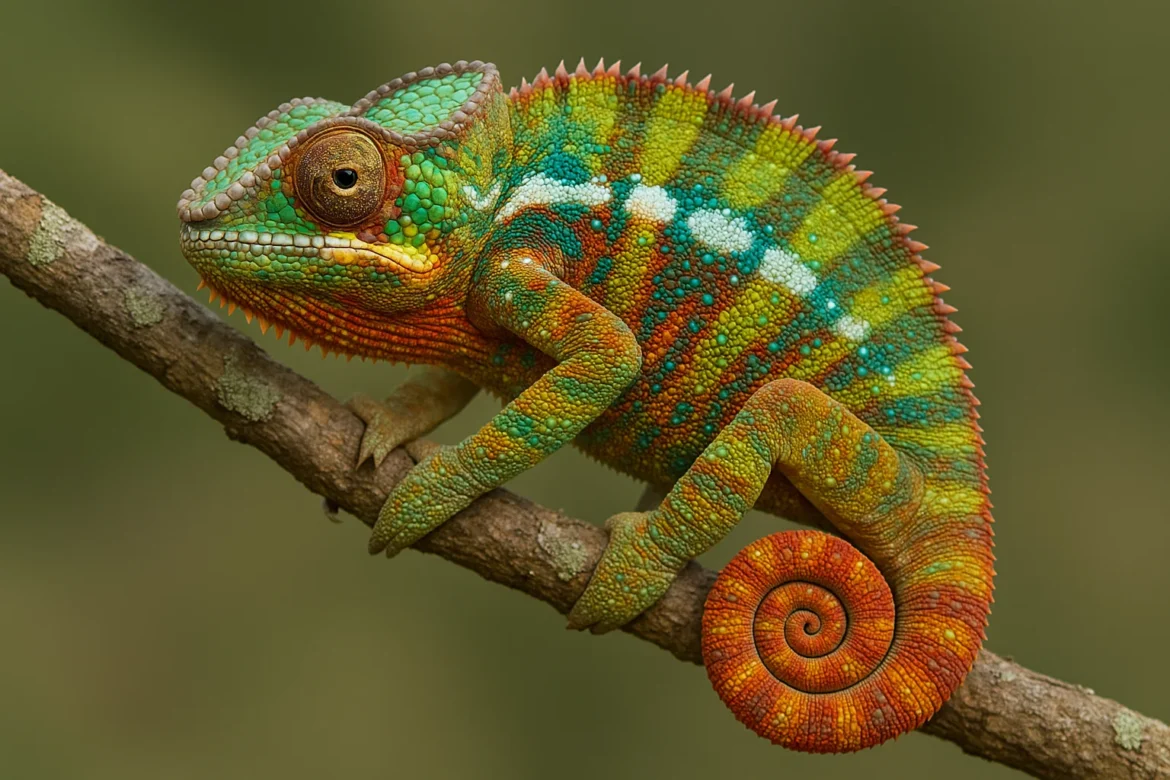
Introduction to Chameleónovité
The term chameleónovité refers to the family of lizards known as chameleons, scientifically classified under the family Chamaeleonidae. These creatures are some of the most unique reptiles in the animal kingdom, instantly recognizable for their striking color-changing abilities, independently moving eyes, and highly specialized tongues used for catching prey. Found primarily in Africa, Madagascar, parts of Asia, and southern Europe, chameleons have captured the imagination of scientists, wildlife enthusiasts, and cultures for centuries.
Their remarkable features go beyond just their external appearance; they are living examples of evolutionary ingenuity, adapting to their environment in ways that few other reptiles have achieved. To understand chameleónovité is to step into a world where biology, adaptation, and mystery coexist seamlessly.
Origins and Evolutionary History
Chameleónovité belong to the order Squamata, which includes other lizards and snakes. Fossil evidence suggests that chameleons may have originated around 100 million years ago during the Cretaceous period, making them one of the older reptile lineages still in existence. Their evolutionary adaptations, such as zygodactylous feet (two toes facing forward and two backward) and prehensile tails, allowed them to thrive in arboreal environments.
The evolutionary path of chameleónovité is particularly interesting because it highlights how animals can evolve highly specific traits not only to survive but also to dominate particular ecological niches. The variety of species across different continents showcases both adaptive radiation and environmental influence, with Madagascar being the hotspot for chameleon diversity, hosting over half of the known species.
Anatomical Features That Define Chameleónovité
One of the first things people notice about chameleónovité is their unusual anatomy. Their bodies are laterally compressed, giving them a narrow profile that helps with camouflage. Their eyes can move independently, offering almost 360-degree vision, and their tongues are not only long but also elastic, capable of shooting out at incredible speeds to capture prey with sticky tips. Chameleons also possess casque-shaped or helmet-like crests on their heads, which differ in size depending on the species.
These anatomical features are not just for aesthetics; they are key to survival in dense forests and open savannas where both predators and prey require extraordinary strategies for success. The body structure of chameleónovité is a testament to the perfection of evolutionary adaptation.
Color Changing Abilities
The most iconic trait of chameleónovité is their ability to change color. Contrary to popular belief, this ability is not primarily for camouflage. While blending into surroundings is one purpose, chameleons also change color for thermoregulation, communication, and signaling moods. Specialized skin cells called chromatophores contain pigments that can expand or contract, while guanine nanocrystals reflect light to create vivid hues.
For example, a chameleon may turn darker to absorb more heat when cold, or display bright colors to attract mates or ward off rivals. The intricate science behind these changes has fascinated biologists and physicists alike, making chameleons a subject of countless studies on optics, nanotechnology, and evolutionary biology.
Distribution and Habitat
Chameleónovité are primarily distributed across Madagascar, mainland Africa, parts of southern Europe, the Middle East, and parts of South Asia. Madagascar alone is home to nearly half of the world’s chameleon species, ranging from the tiny Brookesia nana, one of the smallest reptiles on Earth, to the large and majestic Parsons chameleon. The habitats of these reptiles vary widely, from rainforests and woodlands to dry savannas and even mountainous regions.
Their adaptations allow them to thrive in different ecological settings, yet habitat destruction due to deforestation and human encroachment threatens their populations. Understanding their habitats is crucial for conservation efforts, especially given their ecological importance in insect control and biodiversity balance.
Diet and Feeding Behavior
 Chameleónovité are primarily insectivorous, feeding on a variety of insects such as crickets, grasshoppers, and flies. Larger species are also known to consume small birds and other lizards. The feeding behavior of chameleons is one of the most fascinating aspects of their biology. Their projectile tongues, which can be up to twice the length of their bodies in some species, can strike prey in fractions of a second. This unique adaptation ensures a high success rate in capturing fast-moving insects. Observing a chameleon feed is like watching a living example of precision engineering, with every movement timed perfectly to ensure survival.
Chameleónovité are primarily insectivorous, feeding on a variety of insects such as crickets, grasshoppers, and flies. Larger species are also known to consume small birds and other lizards. The feeding behavior of chameleons is one of the most fascinating aspects of their biology. Their projectile tongues, which can be up to twice the length of their bodies in some species, can strike prey in fractions of a second. This unique adaptation ensures a high success rate in capturing fast-moving insects. Observing a chameleon feed is like watching a living example of precision engineering, with every movement timed perfectly to ensure survival.
Reproduction and Life Cycle
The reproductive behavior of chameleónovité varies across species but generally involves courtship displays where males showcase vibrant colors to attract females. Some species lay eggs, while others give live birth. Females typically dig burrows in soil to deposit their eggs, which then incubate for several months depending on environmental conditions. The life cycle of chameleons is relatively short compared to other reptiles, with many species living only 2 to 10 years in the wild. However, within that short time, they undergo dramatic transformations and adaptations, highlighting the fragile yet remarkable existence of these reptiles.
Chameleónovité and Their Role in Ecosystems
Chameleons are integral components of the ecosystems they inhabit. As insectivores, they play a significant role in controlling insect populations, which in turn helps maintain the balance of local biodiversity. They are also prey for birds, snakes, and mammals, making them essential links in the food chain. Their role extends beyond ecological functionality; they are indicators of environmental health. Declining chameleon populations often signal habitat degradation or climate shifts. In this way, chameleónovité serve as both actors in and witnesses to the changes in their ecosystems.
Cultural Symbolism and Human Interaction
Throughout history, chameleónovité have fascinated human cultures. In many African and Malagasy traditions, chameleons are considered mystical creatures associated with transformation, adaptability, and spiritual significance. Their ability to change color has been linked to themes of deception, flexibility, and adaptability in various folklore traditions. In modern culture, chameleons appear frequently in art, literature, and even branding, symbolizing change and uniqueness.
On the scientific side, they are popular among herpetologists and reptile enthusiasts, often kept as exotic pets, though this raises ethical and conservation concerns. Human interaction with chameleons has been both admiring and exploitative, highlighting the delicate balance between fascination and responsibility.
Chameleons in Captivity
Keeping chameleónovité as pets has become increasingly common, especially with species like the veiled chameleon (Chamaeleo calyptratus) and panther chameleon (Furcifer pardalis). However, chameleons are notoriously difficult to care for due to their specific habitat requirements. They need controlled humidity, proper UV lighting, live prey, and specialized enclosures to thrive in captivity.
Many chameleons suffer from poor health in captivity when these needs are not met, raising ethical debates about whether they should be domesticated at all. Responsible breeding and ownership are vital to ensuring their welfare, yet the demand for exotic pets continues to threaten wild populations through illegal collection and trade.
Threats and Conservation Challenges
The survival of chameleónovité faces multiple threats, primarily driven by human activity. Habitat loss due to deforestation, agriculture, and urbanization is the most pressing challenge. Climate change also impacts their habitats, altering rainfall patterns and temperature ranges critical for their survival. Additionally, the illegal wildlife trade continues to endanger several species, with demand for exotic pets fueling smuggling and over-collection.
Conservation organizations are working to protect their natural habitats, enforce anti-poaching laws, and raise awareness about the importance of these reptiles. The International Union for Conservation of Nature (IUCN) lists many chameleon species as vulnerable or endangered, highlighting the urgent need for global conservation efforts.
Scientific Research and Discoveries
Chameleónovité continue to be subjects of scientific fascination. Researchers study their biomechanics, particularly their tongue projection and color-changing mechanisms, to develop insights into materials science, robotics, and nanotechnology. Their unique vision, capable of focusing independently with high precision, has inspired studies in optics and neurology.
Chameleons also serve as models for understanding evolutionary biology, given their specialized adaptations and ecological niches. Each discovery about these reptiles not only deepens our understanding of them but also contributes to broader scientific and technological advancements.
Chameleónovité in Popular Media
In recent years, chameleons have become iconic figures in popular culture. Movies, cartoons, and advertisements often use them as symbols of change, adaptability, and uniqueness. Characters like Pascal from Disney’s Tangled or Karma the chameleon in various children’s programs embody these qualities, making the reptiles relatable and beloved worldwide.
This media presence has helped increase public awareness and appreciation for chameleons, though it also sometimes oversimplifies their complex biology. Nevertheless, popular culture continues to influence perceptions of chameleónovité, bridging the gap between science and everyday life.
Future Outlook
The future of chameleónovité depends heavily on conservation action, sustainable coexistence with humans, and continued scientific research. As climate change accelerates and habitats shrink, their survival faces greater uncertainty. However, increased awareness, community-driven conservation programs, and stronger international laws protecting endangered species provide hope.
Advances in captive breeding and habitat restoration also offer potential pathways for sustaining populations. The fate of chameleónovité is not just about preserving a group of reptiles; it is about maintaining ecological balance, cultural heritage, and the marvels of evolution.
Conclusion
Chameleónovité are far more than color-changing reptiles. They represent an extraordinary branch of evolutionary history, embodying adaptability, complexity, and mystery. From their specialized anatomy and ecological roles to their cultural symbolism and conservation challenges, they are a living reminder of nature’s creativity. Protecting them ensures not only the survival of unique reptiles but also the preservation of ecosystems and the continuation of scientific discoveries. In many ways, the story of chameleónovité is the story of adaptation itself, a narrative that resonates with both science and the human spirit.
Also Read: Döziv


